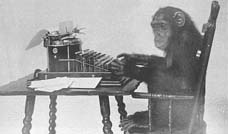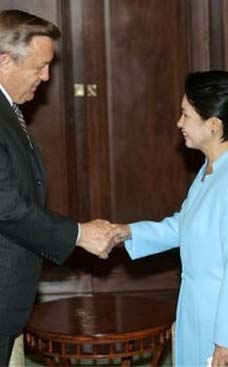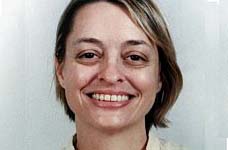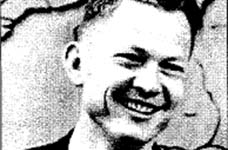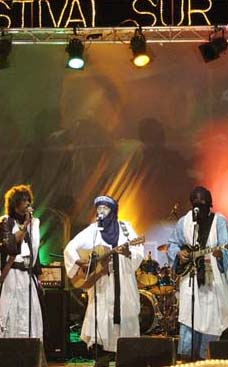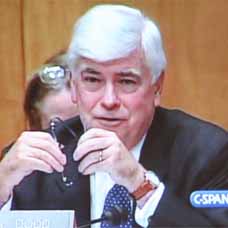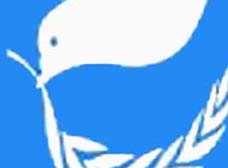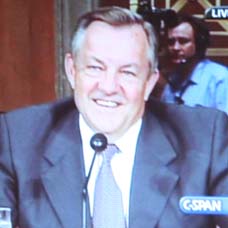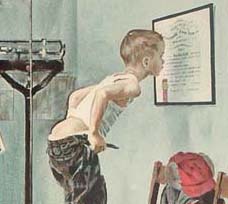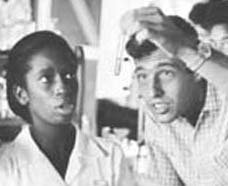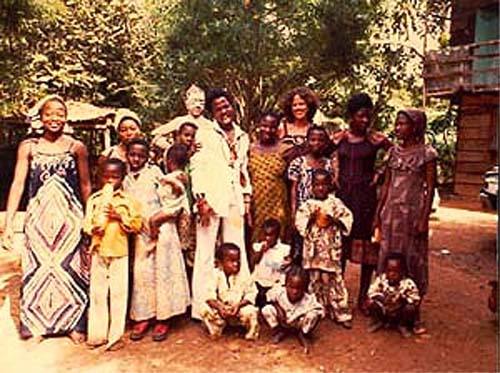
Intent on living in Africa, I joined the Peace Corps and spent the next four years in Africa and the West Indies. There I had two experiences which probably were the beginning of my fall from the art world, although I didn't know it at the time. While I was teaching art in a rural secondary school in Lesotho, Southern Africa, I noticed that sometimes one student would begin a drawing and would then pass it on to another, who would finish it. This fascinated me and went against everything I'd been taught in art school, where the cult of the individual was powerful and one wouldn't dream of making a mark on another's work. These students didn't think twice about sharing their images, nor did they seem particularly attached to them after they were finished, often leaving their work behind without a care. It seemed that the only thing that really meant something to them was the experience of creating the work.
In 1998 I was asked to help produce the first art exhibit about Burning Man, at the San Francisco Art Commission Gallery. The purpose of the exhibit was not to sell art but to show those who weren't able to get out to the playa what was happening out there. After working with these artists I realized that I was much better suited to curating than to making art. After the isolation of working alone in the studio and the struggle to survive in New York, I was very happy to be involved with a group of artists who were working together in this unique community. For the first time I felt connected to something much bigger than myself, having found a nascent art world I could believe in and to which I could apply my skills in a way that felt positive and oriented towards a new vision of art making, one not driven by commerce and marketing but by the collective joy of creating together.
Jamaica and Lesotho RPCV Christine Kristen writes: How I Fell From the Art World and Landed at Burning Man
Curator's Statement: How I Fell From the Art World and Landed at Burning Man
By Christine Kristen aka LadyBee
(Note: This essay grew out of the introduction to a slide presentation on the art of Burning Man given at White Columns Gallery, New York, on April 26, 2002.)
Caption: With the painter Twins Seven Seven and his family in Oshogbo, Nigeria, 1978
As a child I loved to paint and draw and by the time I finished high school I had decided to devote myself to the making of art. I went to art school in the seventies and completed an MFA in sculpture from the School of the Art Institute of Chicago, fully intending to pursue a gallery career, but I got sidetracked by my curiosity about African culture, which had evolved during several years of studying West African dance. Intent on living in Africa, I joined the Peace Corps and spent the next four years in Africa and the West Indies. There I had two experiences which probably were the beginning of my fall from the art world, although I didn't know it at the time. While I was teaching art in a rural secondary school in Lesotho, Southern Africa, I noticed that sometimes one student would begin a drawing and would then pass it on to another, who would finish it. This fascinated me and went against everything I'd been taught in art school, where the cult of the individual was powerful and one wouldn't dream of making a mark on another's work. These students didn't think twice about sharing their images, nor did they seem particularly attached to them after they were finished, often leaving their work behind without a care. It seemed that the only thing that really meant something to them was the experience of creating the work.
In West Africa I encountered a culture where artists were welcomed into the general community and worked side by side with everyone else; they created work that was used, sometimes ritually, by the community, and which was held in very high esteem. The community was intimate with the objects they made, and everyone seemed to feel connected to them and to genuinely care about them. This of course was quite different from the world I came from where most people had little or no interest in art objects, and where the artists felt disconnected from the rest of the culture. In addition, almost everyone here made some kind of decorative art object which was used every day, and there really didn't seem to be much separation between art and life. Of course the purpose of this art was different than Western art, which is based on self-expression and the individual and not intended for any sort of practical use; nevertheless a kind of wholeness seemed to exist here, which was very attractive to me after experiencing the fragmented life of an artist struggling to survive in a culture which didn't seem to place much value on art. However, I didn't quite know how to work and survive outside the world in which I was trained and I returned to Chicago and continued making my work. I started exhibiting and selling my work, and after a few years I decided to move to New York, the great proving ground for artists. In 1984 I took up residence in Williamsburg, Brooklyn, where I spent the rest of the eighties.
In Chicago, I was surrounded by an intimate community of peers, but when I moved to New York I became one of thousands of painters and sculptors all struggling to get their work seen in an intensely competitive environment. I spent a lot of time, like everyone else, going to openings, dropping slides off at galleries, and trying to meet critics, dealers and curators. It occurred to me that all of us were engaged in this rather soulless pursuit that reflected only itself and had very little to do with anyone outside our immediate circle. It seemed as if the artists were making art for the other players in the art world, who had inside information on the nature of that work. For the general public, who didn't have this special information, the work was confusing and out of reach.
Even the realm of public art had an unpleasant aspect of separation from the communities for which it was destined. The most notable example of this is Richard Serra's Tilted Arc. This project was selected by committee and installed in a public space. A great curved wall of steel suddenly divided an open plaza bordered by high-rise buildings, and the workers in these buildings had to walk around it, no longer able to enjoy the open space they had once used. Eventually the piece was removed and the whole incident caused a great debate in the art world about the nature of public art. Should educated art professionals decide what is "good" art and impose it on an unwelcoming public whether they like it or not? Or should a community have some say in the kind of art they are going to live with? This incident perpetuated the idea that the art world is detached from ordinary people and has an innate sense of superiority. Of course there are many other public art programs that take a different approach, sending an artist into a community to work with its members. In such programs the community members work with the artist and everyone learns and feels connected to the work, which has meaning to the community.
In any case, I felt a great deal of separation between the art world which I was struggling to break into, and the rest of the world around me. I didn't see much cooperation or collaboration between artists, but a lot of competition which didn't bring us together, but separated us. In an artificial world in which resources were extremely scarce, it's not suprising that we guarded whatever we could get, and very carefully. In addition, the eighties was the decade of the great art-buying boom; the economy was very healthy and it became lucrative to collect art. Certain galleries started promoting very young artists, manipulating the market and driving up prices, and soon the twenty-something art superstar was born. For those of us struggling to make a living and to get our work shown, this was extremely demoralizing.
I began to question the value system around me, which was ultimately exclusionary, market-driven, and isolating. As I became more alienated from the world I had chosen to live in, I was no longer quite sure why I was making art anymore, and I stopped altogether and moved to San Francisco.
In August of 1995, on a whim, I drove to the Black Rock Desert with a girlfriend, with only a vague idea of what I was journeying toward, having seen Burning Man in a list of summer festivals in the Bay Guardian. I was dazzled by the setting and by the event, thrilled by the creativity, energy, and good will of the community, and delighted that I had stumbled upon something I knew would change my life. I found a group of people who were alienated not only from the art world but from the mainstream culture in general, and were doing something about it.
Out on the playa they were creating their own culture, which seemed to be based on humor, play, imagination, sharing, cooperation, and personal responsibility. I felt I'd somehow come home, and I proceeded to become deeply involved in the community back in San Francisco as well as on the playa.
There wasn't much art on the playa in 1995, but as more artists created bigger and more complex installations each year, it occurred to me that a new kind of art-making was evolving, completely outside of the mainstream art world. On the playa, artists weren't attached to sole ownership of their work, which was community-based and communally built. Groups of artists and friends worked together on projects, sharing resources and co-operating instead of competing. In this world there was no lack of resources; sharing seemed the natural thing to do. This cooperative spirit seemed to engender a super-abundance of goods, which everyone freely exchanged. Strangers could come along and work on an installation merely because they liked the look of it; no one asked for credentials but welcomed anyone who seemed willing to help out. This art was a vital part of the community, embraced by all.
Most amazing to me was the sense that these artists were so far removed from notions of preciosity and market value that they were actually burning their work at the end of the event. They weren't trying to attract a dealer or a collector; they weren't trying to get into a gallery, nor were they looking for the attentions of a critic. They weren't doing it solely for themselves - they were doing it for the experience and for the community.
In 1998 I was asked to help produce the first art exhibit about Burning Man, at the San Francisco Art Commission Gallery. The purpose of the exhibit was not to sell art but to show those who weren't able to get out to the playa what was happening out there. After working with these artists I realized that I was much better suited to curating than to making art. After the isolation of working alone in the studio and the struggle to survive in New York, I was very happy to be involved with a group of artists who were working together in this unique community. For the first time I felt connected to something much bigger than myself, having found a nascent art world I could believe in and to which I could apply my skills in a way that felt positive and oriented towards a new vision of art making, one not driven by commerce and marketing but by the collective joy of creating together.
